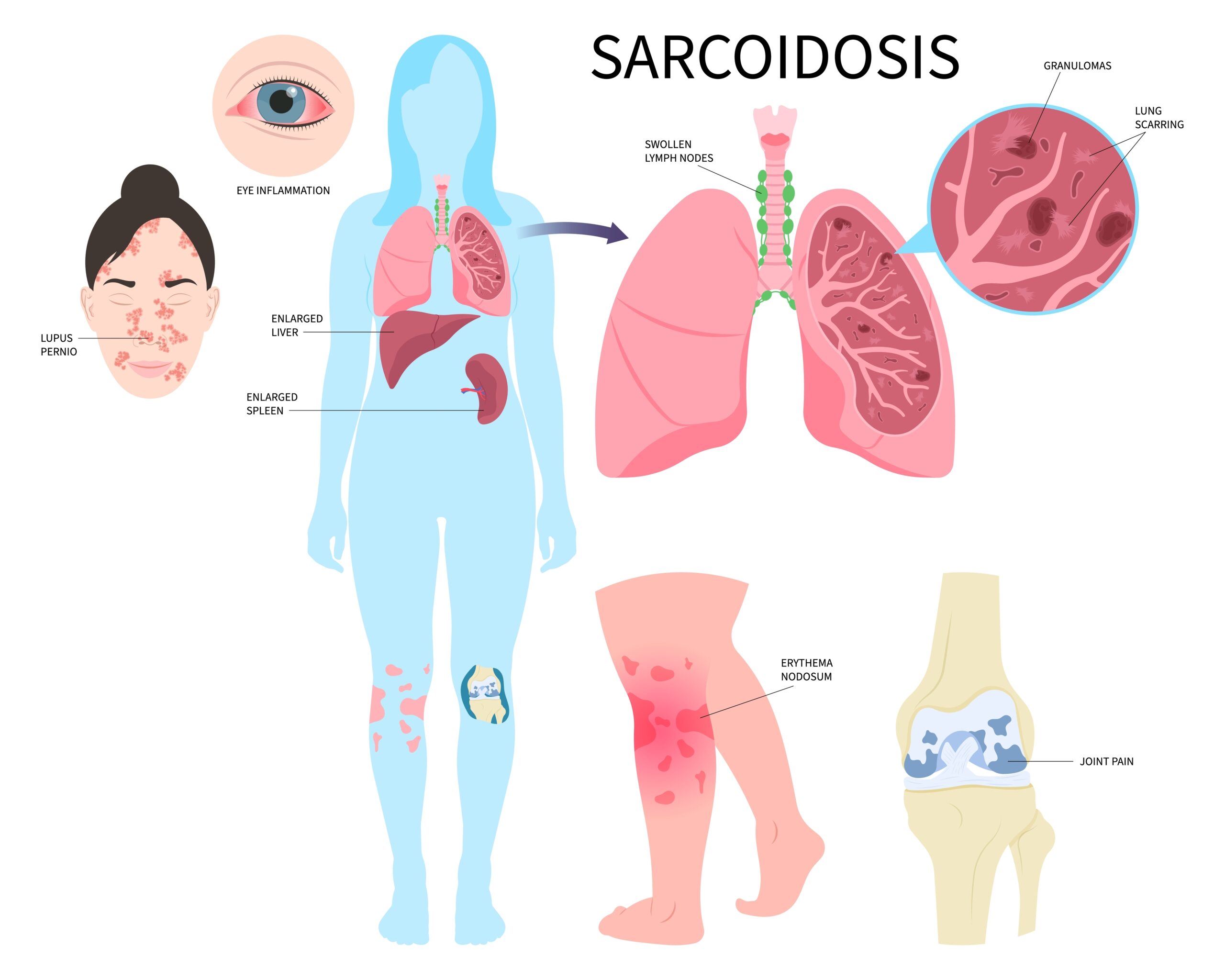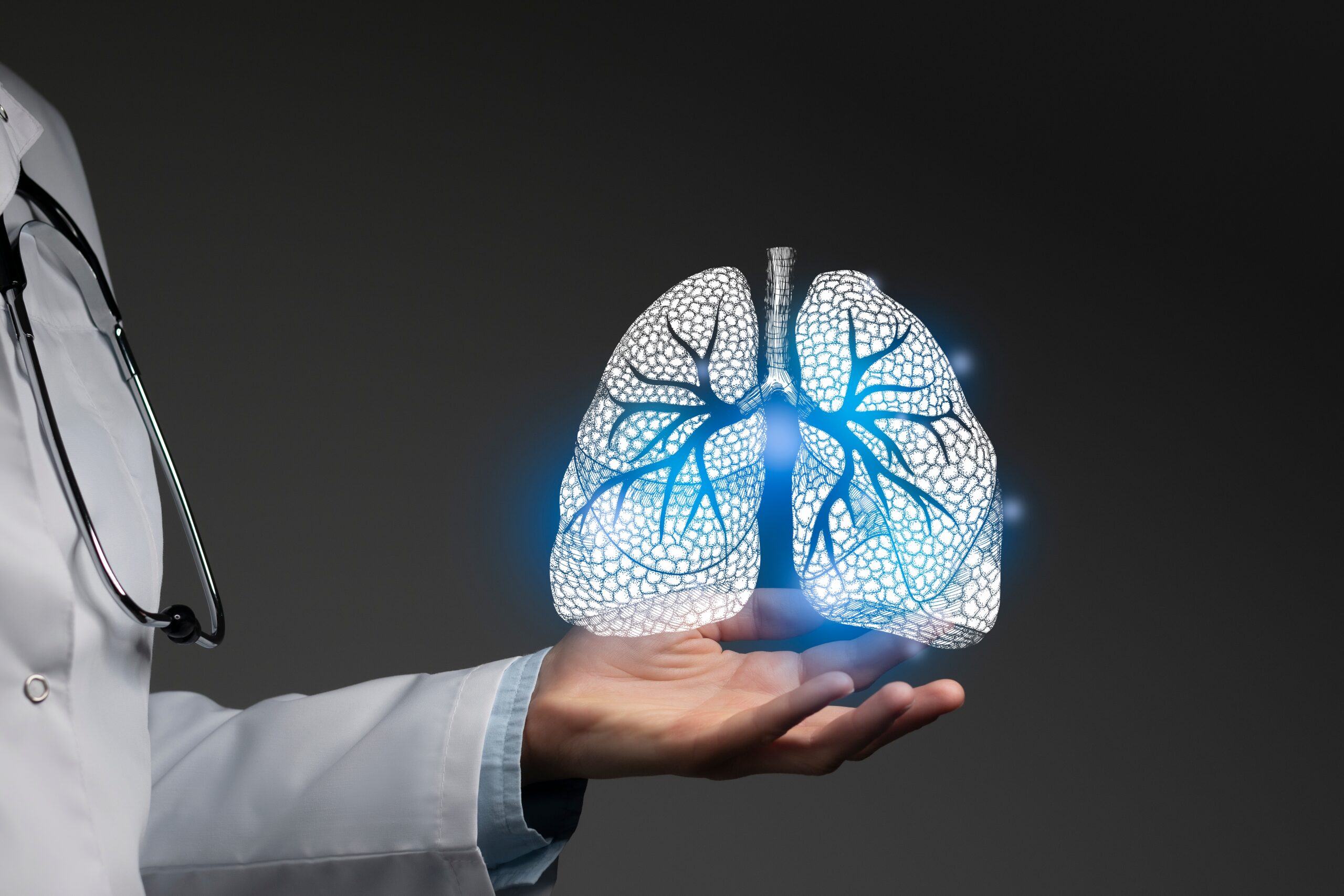Sarcoidosis is an autoimmune disease, meaning the immune system starts attacking its body. It cannot be infected. It most often occurs in young people aged 20-30 and women aged 50-60. It attacks the entire body, forming small inflammatory lumps called granulomas.
They arise from white blood cells (primarily lymphocytes and macrophages), which, unlike tuberculosis, do not undergo caseation. Because the disease most often affects the lungs and mediastinal lymph nodes, impairing gas exchange, it is also classified as interstitial lung disease. Sarcoidosis can also attack other organs, such as the heart, liver, muscles, joints, spleen, eyes, etc., causing dysfunction.
The causes of sarcoidosis are unknown. Scientists suspect that the immune system's reaction to an unidentified antigen (a substance in the body detected by specific immune system cells) is responsible for developing the disease. The antigen can also stimulate the production of antibodies directed against itself.

Sarcoidosis can be influenced by genetic factors and the presence of the disease in one's family. In fact, relatives of individuals with sarcoidosis have a four times higher risk![]() of developing the disease.
of developing the disease.
In addition to genetic predisposition, infection also plays a role in sarcoidosis. There is suspicion that certain bacteria, such as those causing tuberculosis![]() , as well as various viruses, may contribute to the development of sarcoidosis. Moreover, prolonged exposure to organic dust, mold, pesticides, or working in industries involving metal and stone processing are other potential triggers of sarcoidosis.
, as well as various viruses, may contribute to the development of sarcoidosis. Moreover, prolonged exposure to organic dust, mold, pesticides, or working in industries involving metal and stone processing are other potential triggers of sarcoidosis.
Sarcoidosis is a rare condition that affects around 150,000 to 200,000 individuals![]() in the United States. Among different racial groups, black women have the highest incidence rate of this disease.
in the United States. Among different racial groups, black women have the highest incidence rate of this disease.
Sarcoidosis may be asymptomatic. Approximately 50-70%![]() of patients experience general symptoms, the so-called non-specific symptoms, which include:
of patients experience general symptoms, the so-called non-specific symptoms, which include:
Symptoms may concern the organ in which the disease develops and may only occur periodically. Up to 90% of cases![]() involve sarcoidosis of the lungs and lymph nodes, and therefore the symptoms usually include:
involve sarcoidosis of the lungs and lymph nodes, and therefore the symptoms usually include:
The onset of the disease may be acute, with fever, joint pain, and skin lesions. The accompanying skin lesions are called erythema nodosum. Erythema nodosum is a reddish-violet patch of various sizes on the skin, sometimes warmer than healthy skin, which disappears without leaving scars but with discoloration that lasts for weeks. They are often located on the lower legs, sometimes thighs, buttocks, and other body parts.
Much less frequently, sarcoidosis affects the nervous system, heart, eyes, and salivary glands. The symptoms are then related to damage to the affected organ.
This condition can affect most organs in the body. Most often (in 90% of patients![]() ), it attacks the lungs and lymph nodes in the lung cavities. This manifests as shortness of breath, cough, and chest pain when moving or resting.
), it attacks the lungs and lymph nodes in the lung cavities. This manifests as shortness of breath, cough, and chest pain when moving or resting.

Skin sarcoidosis is a relatively common manifestation of this disease. Its characteristic feature is the appearance of erythema nodosum – a significant, painful red inflammatory rash, most often on the front surface of the lower legs. Others include papular lesions, small underskin nodules, ulcers, discoloration, and alopecia.
The disease also attacks the heart and may lead to the appearance of fluid around the heart, heart rhythm abnormalities and function disturbances.
The eyes are another organ that may be affected by the disease. The middle layer of the eye becomes inflamed, causing redness and pain. Eye symptoms![]() may include:
may include:
The disease also affects the salivary glands, i.e., large glands that produce saliva, causing them to swell and become painful.
Sarcoidosis can sometimes result in inflammation of the nerves, which can lead to impaired function. This can cause pain, reduced sensation, and weakened muscle strength. Individuals with this condition may also experience joint pain in the knees, ankles, and elbows. Enlargement and pain in the spleen and liver and swelling of the lymph nodes at the back of the head are other possible effects of sarcoidosis.
In certain cases, the onset of sarcoidosis can be acute, with symptoms such as fever, joint pain, skin lesions, and an enlargement of the lymph nodes near the lungs. This cluster of symptoms is known as Lofgren's syndrome![]() .
.
The exact cause of sarcoidosis is still unknown. However, the development of the disease appears to be related to genetic and environmental factors. A person genetically predisposed to the disease may manifest it if they encounter triggering environmental factors.
The following risk factors![]() may contribute to the induction of the disease:
may contribute to the induction of the disease:
Sarcoidosis comes in two forms:
Since the disease can attack any organ, certain functional deviations may be observed in various laboratory tests.
Blood tests that show abnormalities in the disease include, for example:
Diagnosis of the disease is based mainly on imaging tests and biopsies of affected tissues, which can ultimately confirm the diagnosis. The most common samples are taken from the lymph nodes, lungs, conjunctiva (the membrane on the eye’s front surface), liver, kidneys, and skin.
In addition to blood tests, the following help diagnose the disease:
Not everyone with sarcoidosis requires treatment. For some individuals, the condition resolves itself without intervention. However, when treatment is necessary, the objective is to attain remission, whereby the disease remains present in the body but does not provoke any symptoms. The specific treatment methods depend on the symptoms displayed and the organs affected.
The primary treatment for sarcoidosis, a condition characterized by abnormal immune responses, is corticosteroid medication. This type of medicine helps to suppress the immune system reactions. There are various types of steroid medicine: pills, topical medication, eye drops, injections, or drugs administered by inhalation.
Like every medication, corticosteroids, when used long-term, have side effects. These include:
Other drugs![]() used to lower the immune system activity during the disease include:
used to lower the immune system activity during the disease include:

The disease has a good prognosis. In the most common form of the disease, it usually regresses without treatment. Clinical studies have shown that the condition disappears spontaneously within two years in most patients. In other cases, it may progress and gradually impair the functioning of the respiratory system. In about 5% of cases![]() , it ends in death. This usually occurs due to impaired lung function, central nervous system involvement, or heart failure.
, it ends in death. This usually occurs due to impaired lung function, central nervous system involvement, or heart failure.
Since sarcoidosis can affect various organs, its complications may concern any of them.
If the disease remains untreated for an extended period, it can lead to permanent scarring of the lungs (pulmonary fibrosis) and pulmonary hypertension. Those conditions cause breathing difficulties.
If the disease affects the eyes, it can lead to blindness since the retina may become damaged. Sarcoidosis, at times, can lead to the development of glaucoma, a condition characterized by increased pressure within the eye, or cataracts, which cause cloudiness in the eyes.
Excessive calcium in the body can disrupt calcium metabolism and cause various health issues, including the formation of kidney stones and impaired kidney function. In severe cases, this can even result in kidney failure.
Sarcoidosis affects the heart by forming granulomas, leading to irregular heart rhythms and hindering blood flow. This can ultimately impair the heart's ability to function correctly, and in some rare cases, it can even be fatal.
Some individuals with sarcoidosis may experience complications involving their central nervous system when granulomas develop in the brain and spinal cord. One potential effect is inflammation in the facial nerves, which can lead to facial paralysis.
The cause of sarcoidosis remains a mystery, making prevention impossible. However, certain measures can assist in preventing symptoms in individuals who are more susceptible to the disease. These include:
Sarcoidosis, due to its often non-specific symptoms, may raise the suspicion of cancer. Both lung cancer and sarcoidosis contribute to night sweats. The same applies to other symptoms such as weight loss, fatigue, cough, or chest pain. Also, changes similar to both diseases may be visible in imaging tests, such as lung X-rays. All this can worry the patient, who often begins to ask the question, is sarcoidosis a cancer?
However, these are two significantly different diseases. Sarcoidosis results from immune system disorders of unknown origin and is a lung disease. Lung cancer, however, has a genetic basis and uncontrolled division of cancer cells.
Living with sarcoidosis can be quite a challenge. If you have this condition, it's important to regularly visit your doctor for ongoing care, even if you're not currently experiencing any symptoms. Keeping an eye on your body's condition and actively monitoring for any potential side effects from long-term treatment is necessary when dealing with a chronic disease.
During remission, your healthcare provider might decide to halt the treatment. However, it's crucial to remember that the disease can flare up again. That's why it's important to stay vigilant and carefully observe your body for any signs of symptoms returning. If necessary, treatment can be restarted to address any reappearance of symptoms.
A healthy lifestyle is beneficial because it can prevent disease progression and improve your overall well-being. Making healthy lifestyle changes involves:
Getting a sarcoidosis diagnosis can be stressful and make you feel depressed and worrying. If you feel overwhelmed, you must seek support from your friends and family and visit a counselor. Joining a patient support group may help you adjust to living with the disease.
If you're experiencing symptoms of sarcoidosis, like coughing, difficulty breathing, chest pain, weight loss, fevers, or night sweats, it's important to consult your doctor for proper diagnosis and guidance. Your doctor will closely monitor your condition to determine if it's progressing and adjust your treatment based on your needs.
In some cases, sarcoidosis may resolve on its own without the need for treatment. However, many patients require ongoing treatment to manage their symptoms effectively.
It's common for sarcoidosis to be treated by a team of healthcare professionals working together to provide the best possible care. Because the disease can affect many organs, you may be treated by healthcare professionals specialized in treating the lungs, heart, brain, kidneys, liver, eyes, and skin diseases.